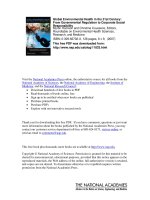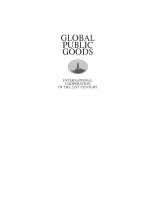Psychology applied to modern life adjustment in the 21st century, 11e chapter 2
Bạn đang xem bản rút gọn của tài liệu. Xem và tải ngay bản đầy đủ của tài liệu tại đây (1.24 MB, 55 trang )
Chapter 2
Theories of Personality
The Nature of Personality
•
•
Personality is “an individual’s unique
constellation of consistent behavioral traits”.
A personality trait is “a durable disposition
to behave in a particular way in a variety of
situations”.
– Common personality traits
• Honest
• Moody
• Impulsive
• Friendly
The Nature of Personality, continued
•
•
Robert McCrae and Paul Costa (1987, 1997,
1999) state that there are five “higher-order”
traits that are known as the “Big Five” (see
Figure 2.1)
1. Extraversion (or positive emotionality)
2. Neuroticism (or negative emotionality)
3. Openness to experience
4. Agreeableness
5. Conscientiousness
However, this is but one of many
perspectives on human personality.
Figure 2.1 The five-factor model of personality. Trait models attempt to break down personality into its
basic dimensions. McCrae and Costa (1987, 1997, 2003) maintain that personality can be described
adequately with the five higher-order traits identified here, widely known as the Big Five traits.
SOURCE: Trait descriptions from McCrae, R.R., & Costa, P.T. (1986). Clinical assessment can benefit
from recent advances in personality psychology. American Psychologist, 41, 1001-1003.
Psychodynamic Perspectives
•
•
•
Psychodynamic theories include a variety
of theoretical models derived from the
work of Sigmund Freud.
All focus on unconscious mental forces
that shape our personalities.
Well-known psychodynamic theorists
– Freud
– Jung
– Adler
– Erikson
Psychodynamic Perspectives, continued
1.Freud’s Psychoanalytic Theory of
personality is somewhat controversial and
is based on three main assumptions
1. Personality is governed by unconscious
forces that we cannot control.
2. Childhood experiences play a significant
role in determining adult personality.
3. Personality is shaped by the manner in
which children cope with sexual urges.
Freud’s Psychoanalytic Theory
•
Freud argued that personality is divided into
three structures
1. The id is “ the primitive, instinctive
component of personality that operates
according to the pleasure principle”.
2. The ego is “the decision-making component
of personality that operates according to the
reality principle”.
3. The superego is “the moral component of
personality that incorporates social standards
about what represents right and wrong”.
Freud’s Psychoanalytic Theory, continued
•
The id, ego and superego are distributed
across three layers of awareness
1. The conscious – “material we are fully
aware of at a particular time”.
2. The preconscious – “material just below
the surface of awareness”.
3. The unconscious – “material well below
the surface of conscious awareness, but
that greatly influences behavior” (see Figure
2.2).
Figure 2.2 Freud’s model of personality structure. Freud theorized that we have three levels of
awareness: the conscious, the preconscious, and the unconscious. To dramatize the size of the
unconscious, it has often been compared to the portion of an iceberg that lies beneath the water’s
surface. Freud also divided personality structure into three components—id, ego, and superego—that
operate according to different principles and exhibit different modes of thinking. In Freud’s model, the id
is entirely unconscious, but the ego and superego operate at all three levels of awareness.
Freud’s Psychoanalytic Theory, continued
•
•
•
Freud believed that behavior is the result of
ongoing internal conflict among the id, ego,
and superego.
Conflicts stemming from sexual and
aggressive urges are especially significant.
Such conflicts arouse anxiety, so we use
defense mechanisms – “largely
unconscious reactions that protect a
person from painful emotions such as
anxiety and guilt”.
Freud’s Psychoanalytic Theory, continued
• Personality development
– Freud believed that the basic elements of
adult personality are in place by age five and
result from the outcome of five psychosexual
stages (see Figure 2.5).
– In each stage, children must cope with
distinct immature sexual urges that influence
adult personality.
– Fixation results if the child fails to move
forward from one stage to another and is
usually caused by excessive gratification, or
frustration of needs at a particular stage.
Figure 2.5 Freud’s stages of psychosexual development. Freud theorized that people evolve through the
series of psychosexual stages summarized here. The manner in which certain key tasks and experiences
are handled during each stage is thought to leave a lasting imprint on one’s adult personality.
Psychodynamic Perspectives, continued
2. Jung’s Analytical Psychology
• Jung also focused on the role of the
unconscious in shaping personality.
• However, he argued that the unconscious is
comprised of two layers
1. The personal unconscious, which
contains the same material as Freud’s
unconscious layer, and
2. The collective unconscious, which
contains traces of memories, shared by
the entire human race, inherited from our
ancestors.
Jung’s Analytical Psychology
•
•
•
The collective unconscious does not contain
memories of distinct, personal experiences.
Rather, it contains archetypes –
“emotionally charged images and thought
forms that have universal meaning”.
Jung was also the first to describe
– Introverted (inner-directed), and
– Extroverted (outer-directed) personality
types.
Psychodynamic Perspectives, continued
3. Adler’s Individual Psychology
• Adler believed that the most important human
•
•
•
drive is not sexuality, but our drive for
superiority.
Adler stated that we use compensation “efforts to overcome imagined or real
inferiorities by developing one’s abilities”.
If we are unsuccessful, we may develop an
inferiority complex – “exaggerated feelings of
weakness and inadequacy”.
Adler also believed that birth order may
contribute to personality.
Evaluating Psychodynamic Perspectives
•
Psychodynamic theory contributed many
important ideas
1. Unconscious forces may contribute to
personality.
2. Internal conflict may play a key role in
psychological distress.
3. Early childhood experiences can influence
adult personality.
4. People may rely on defense mechanisms to
reduce unpleasant emotions.
Evaluating Psychodynamic, continued
•
Psychodynamic theory has also been
criticized
1. Poor testability – it is too vague to subject
to scientific tests.
2. Inadequate evidence – the theories
depend too much on case studies of clients
whose recollections may have been
distorted to fit the theory.
3. Sexism – the theories have a male-oriented
bias and do not adequately address
women’s issues.
Behavioral Perspectives
•
•
•
Behaviorism - “is a theoretical orientation
based on the premise that scientific
psychology should study observable
behavior”.
Behavioral theorists view personality “as a
collection of response tendencies that are
tied to various stimulus situations”.
They focus on personality development,
and how children’s response tendencies
are shaped by classical conditioning,
operant conditioning, and observational
learning.
Behavioral Perspectives, continued
1.Pavlov’s Classical Conditioning is “a type
of learning in which a neutral stimulus
acquires the capacity to evoke a response
that was originally evoked by another
stimulus” (see Figure 2.8).
– Classical conditioning may explain how
people acquire particular emotional
responses such as anxiety or phobias.
Figure 2.8 The process of classical conditioning.
The sequence of events in classical conditioning
is outlined here As we encounter new examples of
classical conditioning throughout the book, you
will see diagrams like that shown in the fourth
panel, which summarizes the process.
Behavioral Perspectives, continued
2.Skinner’s Operant Conditioning is “a form
of learning in which voluntary responses
come to be controlled by their
consequences”.
– Favorable consequences, called
“reinforcers”, tend to cause organisms to
repeat the behaviors that precede them,
and
– Unfavorable consequences, called
“punishers”, tend to discourage
behaviors.
Behavioral Perspectives, continued
•
•
•
Positive reinforcement – “occurs when a
response is strengthened because it is
followed by a pleasant stimulus”.
Negative reinforcement – “occurs when a
response is strengthened because it is
followed by the removal of an unpleasant
stimulus” (see Figure 2.11).
Punishment – “occurs when a response is
weakened because it is followed by an
unpleasant stimulus”.
Figure 2.11 Positive and negative
reinforcement in operant conditioning
Positive reinforcement occurs when a
response is followed by a favorable
outcome, so that the response is
strengthened. In negative
reinforcement, the removal (symbolized
here by the “No” sign) of an aversive
stimulus serves as a reinforcer.
Negative reinforcement produces the
same result as positive reinforcement:
The person’s tendency to emit the
reinforced response is strengthened
(the response becomes more frequent).
Behavioral Perspectives, continued
3.Bandura’s Social Cognitive Theory
– Observational learning - “occurs when an
organism’s responding is influenced by the
observation of others, who are called models”
(see Figure 2.12).
– This theory is unique in that it requires that
we:
• pay attention to others’ behavior,
• understand the consequences that follow
others’ behavior, and
• store this information in memory.
Figure 2.12 Observational Learning. In observational learning, an observer attends to and stores a
mental representation of a model’s behavior (for example, showing off) and its consequences (such
as approval or disapproval from others). According to social cognitive theory, many of our
characteristic responses are acquired through observation of others’ behavior.









